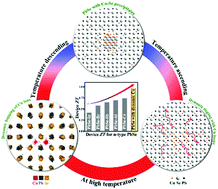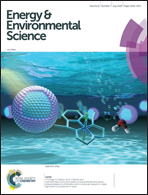Boosting the thermoelectric performance of PbSe through dynamic doping and hierarchical phonon scattering†
Abstract
Here we find the peculiar behavior of Cu ions in the PbSe–Cu system increases its thermoelectric performance. For the electrical transport, a dynamic doping effect is achieved because more Cu ions enter into the PbSe lattice and provide extra charge carriers as the temperature increases, which guarantees an optimized carrier concentration over a wide temperature range. For the thermal transport, the presence of Cu2Se nanoprecipitates and dislocations at a low temperature range as well as the vibration of Cu atoms around the interstitial sites of PbSe at high temperatures result in hierarchical phonon scattering and a significantly reduced lattice thermal conductivity over the whole temperature range. As a result, a peak thermoelectric material figure of merit zT of up to 1.45 and a thermoelectric device figure of merit ZT close to unity are obtained for the sample with 0.375 at% Cu. Furthermore, enhanced thermoelectric properties are also realized for the Cu-intercalated PbS, implying that the temperature-driven dynamic behavior of Cu ions in a rigid lattice can serve as a general strategy to optimize the thermoelectric performance of IV–VI compounds.



 Please wait while we load your content...
Please wait while we load your content...
